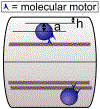Axonal Transport: A Constrained System
- PMID: 30467560
- PMCID: PMC6245579
- DOI: 10.29245/2572.942X/2017/3.1118
Axonal Transport: A Constrained System
Abstract
Long-distance intracellular axonal transport is predominantly microtubule-based, and its impairment is linked to neurodegeneration. Here we review recent theoretical and experimental evidence that suggest that near the axon boundaries (walls), the effective viscosity can become large enough to impede cargo transport in small (but not large) caliber axons. Theoretical work suggests that this opposition to motion increases rapidly as the cargo approaches the wall. However, having parallel microtubules close enough together to enable a cargo to simultaneously engage motors on more than one microtubule dramatically enhances motor activity, and thus decreases the effects due to such opposition. Experimental evidence supports this hypothesis: in small caliber axons, microtubule density is higher, increasing the probability of having parallel microtubules close enough that they can be used simultaneously by motors on a cargo. For transport toward the minus-end of microtubules, e.g., toward the cell body in an axon, a recently discovered force adaptation system can also contribute to overcoming such opposition to motion.
Keywords: Axons; Dynein; Kinesin; Mitochondria; Molecular motors; Neurons; Pain; Theory; Transport.
Figures

Similar articles
-
Axonal transport: how high microtubule density can compensate for boundary effects in small-caliber axons.Biophys J. 2014 Feb 18;106(4):813-23. doi: 10.1016/j.bpj.2013.12.047. Biophys J. 2014. PMID: 24559984 Free PMC article.
-
Axonal transport cargo motor count versus average transport velocity: is fast versus slow transport really single versus multiple motor transport?J Theor Biol. 2015 Apr 7;370:39-44. doi: 10.1016/j.jtbi.2015.01.010. Epub 2015 Jan 20. J Theor Biol. 2015. PMID: 25615423 Free PMC article.
-
Interplay between kinesin-1 and cortical dynein during axonal outgrowth and microtubule organization in Drosophila neurons.Elife. 2015 Dec 28;4:e10140. doi: 10.7554/eLife.10140. Elife. 2015. PMID: 26615019 Free PMC article.
-
Cytoplasmic dynein and microtubule transport in the axon: the action connection.Mol Neurobiol. 1999 Oct-Dec;20(2-3):81-91. doi: 10.1007/BF02742435. Mol Neurobiol. 1999. PMID: 10966115 Review.
-
One axon, many kinesins: What's the logic?J Neurocytol. 2000 Nov-Dec;29(11-12):799-818. doi: 10.1023/a:1010943424272. J Neurocytol. 2000. PMID: 11466472 Review.
Cited by
-
Zebrafish as a Model for the Study of Live in vivo Processive Transport in Neurons.Front Cell Dev Biol. 2019 Feb 19;7:17. doi: 10.3389/fcell.2019.00017. eCollection 2019. Front Cell Dev Biol. 2019. PMID: 30838208 Free PMC article.
-
How neurons maintain their axons long-term: an integrated view of axon biology and pathology.Front Neurosci. 2023 Jul 26;17:1236815. doi: 10.3389/fnins.2023.1236815. eCollection 2023. Front Neurosci. 2023. PMID: 37564364 Free PMC article. Review.
References
-
- De Vos KJ, Grierson AJ, Ackerley S, et al. Role of axonal transport in neurodegenerative diseases. Annu Rev Neurosci. 2008; 31: 151–173. - PubMed
-
- Alberts B Molecular biology of the cell. Sixth edition ed New York, NY: Garland Science, Taylor and Francis Group, 2015.
